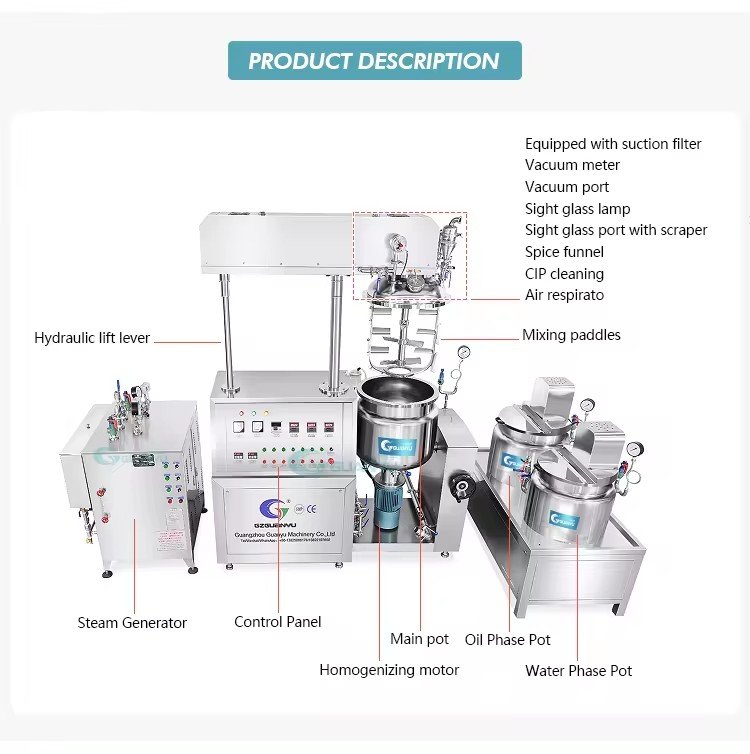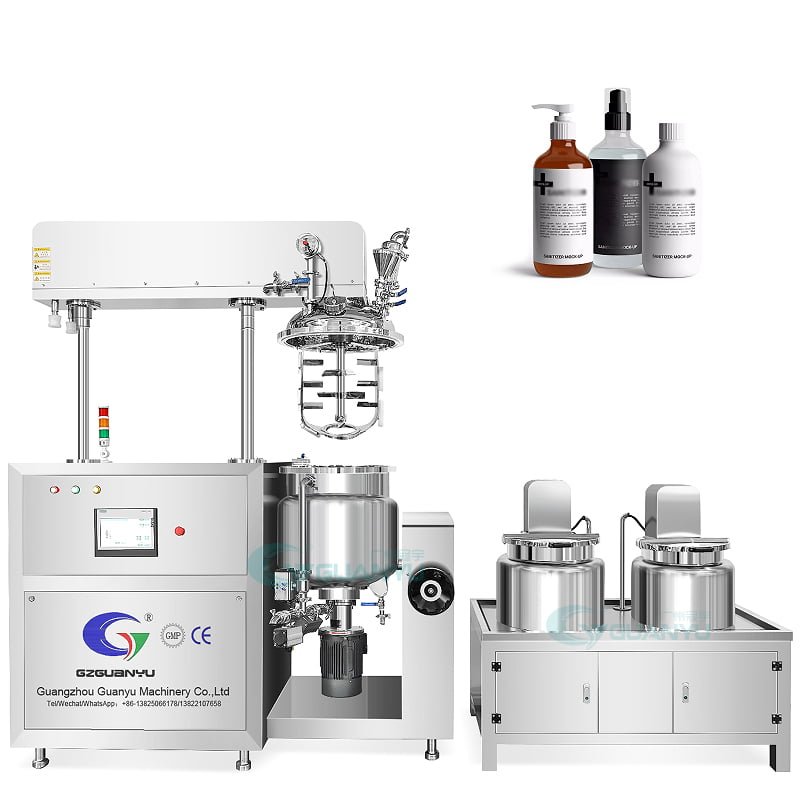ما هي آلة مستحلب?
تلعب آلات المستحلب دورًا حاسمًا في إنتاج مجموعة واسعة من المنتجات, من الطعام ومستحضرات التجميل إلى الأدوية والمواد الكيميائية. تم تصميم آلات المستحلب المتخصصة هذه لإنشاء مستحلبات مستقرة عن طريق خلط شاملان أو أكثر من السوائل غير القابلة للامتصاص, مثل الزيت والماء.
الغرض من آلة المستحلب هو تحطيم قطرات كبيرة من سائل واحد إلى أصغر, قطرات مشتتة بالتساوي داخل سائل آخر, مما أدى إلى خليط متجانس ومستقر. هذه العملية ضرورية لإنشاء منتجات ذات قوام مرغوب فيها, المظاهر, وحياة الرف.
هناك عدة أنواع من آلات المستحلب المتاحة, لكل منها ميزات وقدراتها الفريدة. بعض الأنواع الأكثر شيوعًا تشمل آلات المستحلبات عالية القص, مطاحن غرواني, وآلات مستحلب بالموجات فوق الصوتية.

ما هي الاختلافات بين آلة مستحلب عالية القص وذات القص?
تستخدم آلات المستحلبات عالية القص مجموعة من الدوران عالي السرعة والدفات المتخصصة لتوليد قوى قص مكثفة تنهار بسرعة قطرات كبيرة إلى قطرات أصغر. ينتج عن هذا مستحلب أدق مع توزيع حجم الجسيمات أكثر اتساقًا. غالبًا ما تستخدم آلات المستحلبات عالية القص لإنتاج المستحلبات المنخفضة التنازل, مثل تلك الموجودة في منتجات العناية الشخصية وبعض التطبيقات الغذائية.
في المقابل, تعتمد آلات مستحلبات منخفضة القص على إجراءات خلط ألطف, مثل التحريض البطيء أو شفرات المروحة البسيطة, لخلق المستحلبات. عادة ما تنتج هذه الآلات مستحلبًا خشنًا مع مجموعة واسعة من أحجام القطرات. آلات مستحلبات منخفضة القص أكثر ملاءمة للمنتجات عالية السلاح, مثل الكريمات والمراهم, حيث يمكن للقص المفرط تلف المكونات الحساسة.
كيف تعمل آلات المستحلب?
تعتمد عملية الاستحلاب التي تنفذها آلات المستحلب هذه على مبادئ ديناميات السوائل والكيمياء السطحية. تشمل المكونات الرئيسية لآلة مستحلب غرفة الخلط, مجموعة دوار ستاتور, ومختلف المعلمات القابلة للتعديل مثل السرعة, درجة حرارة, ووقت المعالجة.
أثناء عملية الاستحلاب, السوائل غير القابلية للانسياب (عادة زيت ومرحلة مائية) يتم إدخالها في غرفة الخلط. ثم يطبق مجموعة Stator Rotor قوى القص العالية على الخليط, تحطيم القطرات الكبيرة لسائل واحد إلى أصغر, قطرات مشتتة بالتساوي داخل السائل الآخر. يتم تحقيق ذلك من خلال مجموعة من التحريض الميكانيكي المكثف, الاضطراب, وإنشاء تدرج عالي الضغط داخل الغرفة.
المعلمات القابلة للتعديل لآلة المستحلب, مثل سرعة الدوران, درجة حرارة, ووقت المعالجة, يمكن التحكم بعناية في تحسين عملية المستحلب لتركيبات المنتجات المختلفة والخصائص المطلوبة. عن طريق معالجة هذه المعلمات, يمكن للمصنعين تحقيق حجم القطرات المطلوب, اللزوجة, واستقرار المستحلب النهائي.
تطبيقات آلات المستحلب
تجد آلات المستحلب استخدامًا واسع النطاق في مجموعة متنوعة من الصناعات, لكل منها متطلباتها الفريدة والمواصفات الخاصة بها. تتضمن بعض التطبيقات الرئيسية:
صناعة الأغذية والمشروبات
في قطاع الأغذية والمشروبات, يتم استخدام آلات المستحلب لإنشاء مستحلبات مستقرة للمنتجات مثل المايونيز, ضمادات السلطة, الصلصات, بوظة, ومختلف منتجات الألبان. تساعد عملية الاستحلاب على تحقيق الملمس المطلوب, فم, وحياة الرف من هذه المنتجات.
مستحضرات التجميل ومنتجات العناية الشخصية
تلعب آلات المستحلب دورًا مهمًا في إنتاج منتجات التجميل ومنتجات العناية الشخصية, مثل المستحضرات, كريمات, المراهم, واقي من الشمس. تضمن عملية المستحلب التوزيع الموحد للمكونات النشطة, زيوت, والمكونات القائمة على الماء, مما أدى إلى منتجات ذات خصائص حسية مرغوبة واستقرار.
الصناعات الصيدلانية والكيميائية
في الصناعات الصيدلانية والكيميائية, يتم استخدام آلات المستحلب لإنشاء مستحلبات لأنظمة توصيل الأدوية, المراهم, ومختلف المواد الكيميائية المتخصصة. تساعد عملية المستحلب التي تسيطر عليها على تحسين التوافر البيولوجي, استقرار, وفعالية هذه المنتجات.
اختيار آلة المستحلب الصحيحة
يتطلب اختيار جهاز المستحلب المناسب لتطبيق معين دراسة متأنية للعوامل المختلفة, مثل حجم الإنتاج, لزوجة المنتج, حجم الجسيمات المطلوب, والاحتياجات المحددة للصناعة.
عند اختيار آلة مستحلب, من الضروري التشاور مع الشركات المصنعة والموردين ذوي الخبرة للتأكد من أن المعدات المحددة تلبي المتطلبات الفريدة للتطبيق. يمكنهم تقديم إرشادات حول أنواع الآلات المختلفة, قدراتهم, والتكوين الأنسب للمنتج المطلوب.
ما هي الأنواع المختلفة من آلات مستحلب الفراغ?
آلات مستحلب الفراغ هي نوع متخصص من المستحلبات التي تعمل تحت الضغط الجوي المنخفض. تم تصميم هذه الآلات لإنشاء مستحلبات مع محتوى الهواء المنخفض, مما أدى إلى تحسين الاستقرار, نَسِيج, وحياة الرف.
بعض الأنواع الشائعة من آلات مستحلب الفراغ تشمل:
متجانسة فراغ: تستخدم هذه الآلات مزيجًا من تجميعات دوار عالية السرعة ونظام فراغ لإنشاء مستحلبات دقيقة مع الحد الأدنى من دمج الهواء.
خلاطات فراغ: تستخدم هذه الآلات تحريضًا بطيئًا في ظل ظروف الفراغ لخلط المكونات والمستحلب بلطف, غالبًا ما تستخدم للمنتجات عالية السمنة مثل الكريمات والمراهم.
آلات مستحلب الفراغ مع deaeration: تتميز هذه الآلات بمستحلبات عالية القص ونظام فراغ لإزالة الهواء من المستحلب, إنتاج منتج أكثر استقرارًا واتساقًا.
يعتمد اختيار آلة مستحلب الفراغ على متطلبات المنتج المحددة, خصائص المستحلب المطلوبة, وحجم الإنتاج.
التثبيت والصيانة
يعد التثبيت والصيانة المناسبين لآلة المستحلب أمرًا ضروريًا لضمان أدائه على المدى الطويل وجودة المنتج الأمثل. قبل تثبيت الجهاز, من الضروري إعداد الموقع, ضمان مساحة كافية, المرافق, والضوابط البيئية موجودة.
أثناء عملية التثبيت, يجب أن تكون آلة المستحلب مستوية بشكل صحيح, متصل بالطاقة والمرافق, وتم معايرتها وفقًا لتعليمات الشركة المصنعة. يجب إجراء اختبار شامل والتحقق لضمان عمل الجهاز على النحو المقصود.
الصيانة المستمرة لآلة المستحلبات أمر بالغ الأهمية أيضًا. وهذا يشمل التنظيف العادي, تقتيش, واستبدال أجزاء التآكل وفقًا لتوصيات الشركة المصنعة. يمكن للوثائق المناسبة وحفظ السجلات لأنشطة الصيانة أن تساعد في منع تعطل غير متوقع وضمان الامتثال لمعايير وأنظمة الصناعة.
الامتثال التنظيمي والسلامة
يخضع استخدام آلات المستحلبات لمعايير الصناعة والمتطلبات التنظيمية المختلفة, اعتمادًا على التطبيق المحدد والموقع الجغرافي. يجب على الشركات المصنعة والمشغلين التأكد من امتثال معداتهم وعملياتهم للسلامة ذات الصلة, جودة, واللوائح البيئية.
تشمل شهادات ومعايير الصناعة الشائعة لآلات المستحلبات علامات CE, موافقة FDA, والالتزام بممارسات التصنيع الجيدة (ممارسات التصنيع الجيدة) المبادئ التوجيهية. ميزات السلامة المناسبة, مثل الحراس, توقف الطوارئ, وتدابير الحد من الضوضاء, يجب أن يكون أيضًا في مكانه لحماية المشغلين وضمان بيئة عمل آمنة.
بالإضافة إلى ذلك, التخلص من النفايات الناتجة أثناء عملية الاستحلاب, بالإضافة إلى التأثير البيئي لتشغيل الماكينة, يجب النظر بعناية ومعالجتها لتقليل البصمة البيئية لعملية التصنيع.
استكشاف الأخطاء وإصلاحها والقضايا المشتركة
آلات المستحلب, مثل أي آلية معقدة, يمكن في بعض الأحيان تجربة القضايا أو أعطال. قد تشمل المشكلات الشائعة جودة مستحلب غير متسقة, الرغوة المفرطة, تعطل الآلة, وارتداء أو تلف المكونات الداخلية.
عند استكشاف أخطاء آلة مستحلب, من الضروري اتباع نهج منظم. قد يتضمن ذلك مراجعة معلمات التشغيل, تفقد التآكل أو الضرر, والاستشارات مع الشركة المصنعة للماكينة أو فني خدمة مؤهل. يمكن أن يساعد الحفاظ على سجلات مفصلة لأداء الماكينة وأي مشاكل مواجهتها في تشخيص المشكلات وحلها.
الصيانة الوقائية, معايرة منتظمة, والالتزام بأفضل الممارسات يمكن أن يساعد في تقليل مخاطر المشكلات المشتركة وضمان التشغيل الموثوق على المدى الطويل لآلة المستحلب.


واو فقط ما كنت أبحث عنه. جاء إلى هنا من خلال البحث عن كوبونات Nordvpn إلهام (92url.com) رمز القسيمة الخاص
2024
عمل رائع! هذا هو نوع المعلومات التي يجب مشاركتها عبر الويب.
عار على محركات البحث لعدم وضع هذا الإرسال أعلى!
تعال واستشر موقع الويب الخاص بي . شكرا =)
موقع الويب الخاص بي رمز قسيمة eharmony 2025
مرحبًا ، هل تمانع في مشاركة منصة المدونة التي تستخدمها?
أخطط لبدء مدونتي الخاصة قريبًا ، لكنني أواجه صعوبة في اتخاذ قرار بين المدونة/WordPress/B2Evolution و Drupal.
السبب الذي أسأله هو أن تصميمك يبدو مختلفًا
ثم معظم المدونات وأنا أبحث عن شيء فريد تمامًا.
P.S اعتذاري عن الخروج من الموضوع ولكن كان علي أن أسأل!
انظر إلى صفحة الويب الخاصة بي: VPN
من السهل جدًا معرفة أي موضوع على الشبكة مقارنة بالكتب, كما وجدت هذه القطعة من
الكتابة في موقع الويب هذا. https://tinyurl.com/28555853 gamefly
هذه في الواقع أفكار رائعة في التدوين.
لقد لمست بعض العوامل اللطيفة هنا. بأي طريقة مواكبة الغضب.
ما هو اتصال VPN https://tinyurl.com/2ytofo73
بشكل عام ، لا أتعلم المنشور على المدونات, ومع ذلك أود أن أقول أن هذه الكتابة
أجبرني جدا على إلقاء نظرة على والقيام بذلك! كتابتك
لقد دهشني الذوق. شكرًا, وظيفة جميلة جدا.
نعم! أخيرًا شيء عن VPN.
هذه في الواقع أفكار رائعة في موضوع التدوين.
لقد لمست بعض الأشياء الفائقة هنا. بأي طريقة مواكبة الغضب.
https://tinyurl.com/yneylc4d رمز قسيمة eharmony 2025